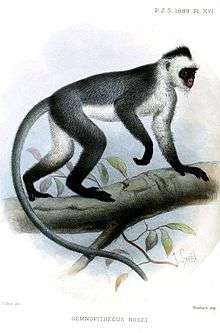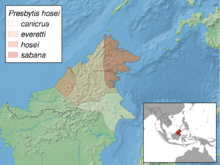Hose's langur
Hose's langur (Presbytis hosei) is a species of primate in the family Cercopithecidae endemic to the island of Borneo, including Brunei, Kalimantan (Indonesia), and East Malaysia. Its natural habitat is subtropical or tropical dry forests. It is threatened by habitat loss.[2] It was first identified in Kutai National Park and Sangkulirang Peninsula, East Kalimantan, Indonesia, in 1985.
| Hose's langur[1] | |
|---|---|
 | |
| Scientific classification | |
| Kingdom: | Animalia |
| Phylum: | Chordata |
| Class: | Mammalia |
| Order: | Primates |
| Suborder: | Haplorhini |
| Infraorder: | Simiiformes |
| Family: | Cercopithecidae |
| Genus: | Presbytis |
| Species: | P. hosei |
| Binomial name | |
| Presbytis hosei (Thomas, 1889) | |
 | |
| After taxonomic revisions, the remaining range for Hose's langur is that shown as P. h. hosei and P. h. everetti | |
Miller's langur (P. canicrus) and the Saban grizzled langur (P. sabana) were previously considered subspecies of Hose's langur.[3][4] There used to also be two additional forms that were considered separate subspecies, P. h. hosei and P. h. everetti. However, P. h. everetti is no longer considered to be a separate subspecies as the original identification of it as a separate subspecies appears to be the result of comparing a subadult female with an adult male.[5][6]
Threatened extinction
In 1996, Hose's langurs of East Kalimantan, Indonesia, were among the most common primates in the area. In 2003, their population densities have decreased by 50–80%.[7] The sudden drop in population arises from the rising demand for its bezoar stones and to prevent crop raiding, and the rapid deforestation and removal of the primate's habitat.
Densities of Hose's langurs positively correlate with tree height, height of the first bough, tree diameter, and canopy cover, and negatively with vegetation cover at low and ground level. With the constant deforestation and destruction of its habitat, Hose's langurs continue to lose their habitat. Every known area in which the primate resides has been affected severely, with the exception of the innermost areas of forests that have been relatively untouched by humans.[8]
References
- Groves, C. P. (2005). Wilson, D. E.; Reeder, D. M. (eds.). Mammal Species of the World: A Taxonomic and Geographic Reference (3rd ed.). Baltimore: Johns Hopkins University Press. p. 171. ISBN 0-801-88221-4. OCLC 62265494.
- Nijman, V.; Meijaard, E. & Hon, J. (2008). "Presbytis hosei". The IUCN Red List of Threatened Species. IUCN. 2008: e.T18128A7666166. doi:10.2305/IUCN.UK.2008.RLTS.T18128A7666166.en.
- "Presbytis canicrus". American Society of Mammalogists. Retrieved 10 April 2020.
- "Presbytis sabana". American Society of Mammalogists. Retrieved 10 April 2020.
- Groves, Colin; Roos, Christian (2013). Mittermeier, Russell A.; Rylands, Anthony B.; Wilson, Don E. (eds.). Handbook of Mammals of the World: Volume 3. pp. 716–717. ISBN 978-8496553897.
- Phillipps, Quentin; Phillipps, Karen (2016). Phillipps' Field Guide to the Mammals of Borneo. Princeton University Press. pp. 164–165. ISBN 9780691169415.
- Vincent Nijman Decline of the endemic Hose's langur Presbytis hosei in Kayan Mentarang National Park, East Borneo April 2005. Retrieved 26 October 2012
- Vincent Nijman Effects of habitat disturbance and hunting on the density and the biomass of the endemic Hose's leaf monkey Presbytis hosei (Thomas, 1889) (Mammalia: Primates: Cercopithecidae) in east Borneo 2004. Retrieved 26 October 2012
